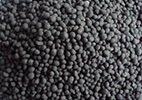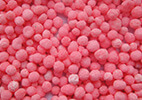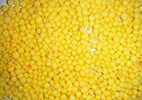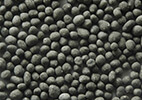



Rotary Drum Granulator
A rotary drum granulator is a granulation device that uses the rotation of a drum to aggregate materials into granules. It is widely used in the field of granule production. Its core operating principle is that the mixed material is fed into an inclined drum. Driven by a motor, the drum rotates, causing the material to tumble and collide within the drum due to the combined effects of gravity, friction, and centrifugal force . Simultaneously, a spray device applies an appropriate amount of water or binder to the material, moistening the surface of the material particles and bonding them together, gradually agglomerating them into granules of a certain strength and size.
This granulation method is a wet granulation method suitable for a wide variety of materials, producing granules with good sphericity and moderate strength. Compared to other granulation equipment, the rotary drum granulator has a high production capacity, enabling continuous large-scale production. Its simple structure and easy operation and maintenance make it a key player in the fertilizer and chemical industries.
Where is the rotary drum granulator commonly used?
The rotary drum granulator has important applications in many industries due to its strong production capacity and wide material adaptability. The specific scenarios are as follows:
Fertilizer field
It can produce various compound fertilizers, organic fertilizers, inorganic fertilizers, etc. It can mix basic fertilizers such as nitrogen, phosphorus, potassium in a certain proportion and granulate them to produce compound fertilizers with different nutrient contents to meet the needs of different crops and soils.
In organic fertilizer production, fermented organic materials such as livestock and poultry manure and straw can be processed into granular organic fertilizer, solving the problem of inconvenient transportation and application of organic fertilizer. At the same time, it can also be used in the production of bio-organic fertilizer. By properly controlling the granulation conditions, the activity of the biological bacteria can be better preserved.
Other industrial fields
Chemical industry: Suitable for granulation of various chemical raw materials, such as catalysts, pigments, detergents, etc. Through granulation, these chemical products have better fluidity, stability and performance, and are easy to store and transport.
Metallurgical Industry: It can be used to granulate metal ore powder, such as iron ore powder, manganese ore powder, etc. After the ore powder is made into granules, it is beneficial to improve sintering efficiency, reduce energy consumption, and improve the quality of metallurgical products.
Building materials industry: It can granulate cement raw materials, ceramsite sand and other building materials, improve the performance of raw materials, and enhance the quality and production efficiency of building materials.
How is the rotary drum granulator designed according to the granulation process?
The structural design of the drum granulator is closely integrated with the granulation process. Each component works together to achieve efficient granulation. Its main components and functions are as follows:
Rotating Drum
It is the core working component of the drum granulator. It is usually a cylindrical barrel, welded with steel plates. The inner wall is generally paved with wear-resistant linings, such as rubber linings, polyurethane linings, etc., to reduce the wear of the material on the drum and extend its service life.
The drum’s diameter and length vary depending on production capacity, with common diameters ranging from 1 to 5 meters and lengths from 3 to 10 meters. The drum is installed at an angle, with the tilt adjustable via a device, typically between 3° and 6°, to ensure smooth movement and tumbling of the material within the drum.
transmission
The drum is composed of an electric motor, a speed reducer, gears, and rollers. The motor provides power, which, after being reduced by the speed reducer, drives the gears or rollers, which in turn drive the drum. The performance of the transmission directly affects the stability of the drum’s speed, which is generally adjustable within a range of 5-20 rpm.
Feeding device
It mainly consists of a hopper and a feeder, which are used to evenly and stably feed the material into the drum. Types of feeders include screw feeders and belt feeders. The appropriate feeding method can be selected according to the characteristics of the material to ensure that the material can enter the drum continuously and evenly.
Spray device
It consists of a water pipe, a water pump, and nozzles, and is used to spray water or a binder onto the material in the drum. The number and position of the nozzles can be adjusted according to the size of the drum and the distribution of the material to ensure that the material is evenly moistened, promoting the formation and growth of particles.
Discharging device
Located at the end of the drum, there is usually an inclined chute or conveyor belt, which is used to transport the finished particles from the drum to subsequent processes such as drying, cooling, screening, etc. The design of the discharge device must ensure smooth material transportation and avoid material blockage.
How does the drum granulator make fertilizer?
The process of manufacturing fertilizer by drum granulator is relatively systematic. Each link has an important impact on the quality of the final product. The specific steps are as follows:
Raw material pretreatment
Various fertilizer raw materials are crushed and screened to achieve the particle size required for granulation, generally between 0.1 and 1 mm. For organic fertilizer raw materials, fermentation and composting are required to remove harmful substances and improve the fertility of the fertilizer.
According to the recipe requirements, various raw materials are accurately measured to ensure that the proportions of each ingredient are accurate.
mix
Place the measured raw materials into the mixer and mix thoroughly to ensure uniform distribution of the ingredients. The mixing time is generally 5-15 minutes. The mixed materials should have good uniformity to ensure the quality of subsequent granulation.
Granulation
The mixed materials are added into the drum through the feeding device. The drum rotates under the drive of the transmission device, and the materials are constantly rolling and colliding in the drum. At the same time, the spray device sprays the materials with an appropriate amount of water or binder, so that the material particles gradually agglomerate into granules.
During the granulation process, the drum speed, tilt angle, and amount of water or binder added need to be adjusted according to the granule formation to ensure granule quality and yield. Generally, the granule diameter can be controlled between 1-6 mm.
dry
The finished pellets contain a high amount of moisture and need to be dried. The pellets are sent to a dryer and dried at a certain temperature (usually 80-150°C) to reduce the moisture content of the pellets to below 10% to prevent the pellets from clumping and deterioration.
Cooling and screening
The temperature of the particles after drying is high and needs to be cooled. Usually a cooler or cooling fan is used to cool the particles down to room temperature.
The cooled particles are screened by screening equipment to separate particles that do not meet the requirements (too large or too small) and return them to the granulation system for re-granulation. The qualified particles enter the packaging process.
Package
Qualified granular fertilizers are packaged after being measured. The packaging materials can be woven bags, plastic bags, etc., which are convenient for storage and transportation.




What are the characteristics and advantages of drum granulator in fertilizer production?
Compared with other granulation equipment, the rotary drum granulator has the following advantages when producing fertilizers:
Large production capacity
The rotary drum granulator adopts a continuous production method and has a large single-machine production capacity. It can produce several tons to dozens of tons of fertilizer per hour, which can meet the needs of large-scale industrial production.
Good particle quality
The fertilizer particles produced have high sphericity, generally reaching more than 80%, smooth surface, uniform particle size, moderate strength, are not easy to break or clump during storage, transportation and use, and have good fluidity.
Wide material adaptability
It can process various fertilizer raw materials, whether inorganic raw materials, organic raw materials, or a mixture of the two, and can achieve good granulation effect. For some materials that are difficult to granulate, they can also be granulated smoothly by adding an appropriate amount of binder.
Easy to operate
The equipment has a simple structure, is easy to operate and master. The operator can effectively control the granulation process by simply adjusting the speed and tilt angle of the drum and the amount of water or binder added.
Stable and reliable operation
The transmission device and supporting structure of the rotary drum granulator are reasonably designed, with stable and reliable operation, low failure rate, small maintenance workload, and can ensure long-term continuous production.
What are the benefits of using a drum granulator to make fertilizer?
Using a drum granulator to make fertilizer has many significant benefits, as follows:
Improve fertilizer utilization
Fertilizer granules produced by a rotary drum granulator have uniform nutrient distribution and slowly release nutrients into the soil, avoiding the nutrient loss caused by the rapid dissolution of traditional powdered fertilizers. Practical applications have shown that using granular fertilizers can increase fertilizer utilization by 10%-20%, helping crops fully absorb and utilize nutrients and promoting crop growth.
Easy to store and transport
Granular fertilizers have high density and small size, requiring minimal storage space. They are also less prone to moisture absorption and agglomeration, offering excellent storage stability. Under well-ventilated and dry conditions, they can be stored for 6-12 months. They also experience minimal loss during transportation, reducing transportation costs by 20%-30% compared to powdered fertilizers.
Facilitates mechanized fertilization
Granular fertilizers have good fluidity, making them easy to apply mechanically. They can be precisely applied using equipment such as seed drills and fertilizer spreaders, improving fertilization efficiency and reducing labor intensity. At the same time, mechanized fertilization ensures even fertilization, preventing the impact of over- or under-fertilization on crop growth.
Meet the needs of different crops
The rotary drum granulator can flexibly adjust the fertilizer formula according to the needs of different crops for nitrogen, phosphorus, potassium and other trace elements at different growth stages, and produce various special fertilizers, such as wheat fertilizer, corn fertilizer, fruit tree fertilizer, etc., to provide precise nutrient support for crop growth and promote high-quality and high-yield crops.
Promoting sustainable agricultural development
The rotary drum granulator can convert various agricultural wastes, livestock and poultry manure, etc. into organic fertilizer, realizing the recycling of resources and reducing the pollution of waste to the environment. When organic fertilizer is applied to the soil, it can improve soil structure and increase soil fertility, which is conducive to the development of ecological agriculture and sustainable agriculture.
How to properly perform regular maintenance on the drum granulator?
In order to ensure the normal operation of the drum granulator and extend its service life, the following regular maintenance work must be done:
Regular inspection of components
Before starting the machine every day, check whether the connections of each component are tight and whether there is any looseness; check whether the transmission device is operating normally and whether there is any abnormal noise; check whether the rotation of the drum is stable and whether there is any deviation; check whether the nozzle of the spray device is blocked and whether the water flow is unobstructed.
Check the wear-resistant lining on the inner wall of the drum every week to see if there is any wear or falling off. If so, replace it in time; check the wear of the supporting wheel and the retaining wheel, and whether the lubrication is good; check the meshing of the gears, and adjust them in time if there is any abnormality.
Check the operating temperature of the motor and reducer every month (normal temperature should not exceed 70℃) and vibration, and deal with any abnormalities in a timely manner; check whether the feeding and discharging devices are blocked or worn to ensure smooth material transportation.
Carry out a comprehensive inspection of the equipment every quarter, including the tightness of the transmission system belt, the lubrication condition of the bearings, the operation of the electrical control system, etc., and replace and repair severely worn parts in a timely manner.
Keep your equipment clean
After each production, clean the remaining material in the drum in time to prevent the material from agglomerating and hardening, which will affect the next production. Use a high-pressure water gun to flush the inner wall of the drum. For tightly bonded materials, use special tools to clean them.
Regularly clean the dust, oil and other debris on the surface of the equipment to keep the equipment clean and tidy, so as to facilitate observation of the equipment’s operating status and detection of potential problems.
Lubrication maintenance
Regularly add lubricating oil or grease to the bearings, gears, and other components of the transmission device according to the equipment manual. Generally, the gear oil of the reducer should be replaced every 1,000 hours of operation, and the bearings should be greased every 500 hours of operation.
When adding lubricating oil (grease), pay attention to the type and amount of oil (grease) to ensure sufficient lubrication and avoid increased wear of components due to poor lubrication.
Drum maintenance
The drum is the core component of the equipment and its deformation should be checked regularly. If the drum is found to be obviously bent or deformed, it should be repaired or replaced in time.
Check the sealing condition of the drum. If any poor sealing is found, the seal should be replaced in time to prevent material leakage and dust flying.
Electrical system maintenance
Regularly check whether the circuit connections of the electrical control system are firm, loose or aging; check whether the electrical components in the control cabinet, such as contactors, relays, sensors, etc., are working properly, and replace them in time if any faults are found.
Regularly clean and debug the electrical control system to ensure its stable and reliable operation and avoid electrical failures affecting the normal operation of the equipment.
Have Any Problem? Please, Contact
Integrity
Adhere to honesty and trustworthiness, be responsible to customers, employees, partners, and society, and establish long-term trust relationships.
Win win
Establish win-win relationships with all stakeholders such as customers, suppliers, and employees to share the fruits of enterprise development.



